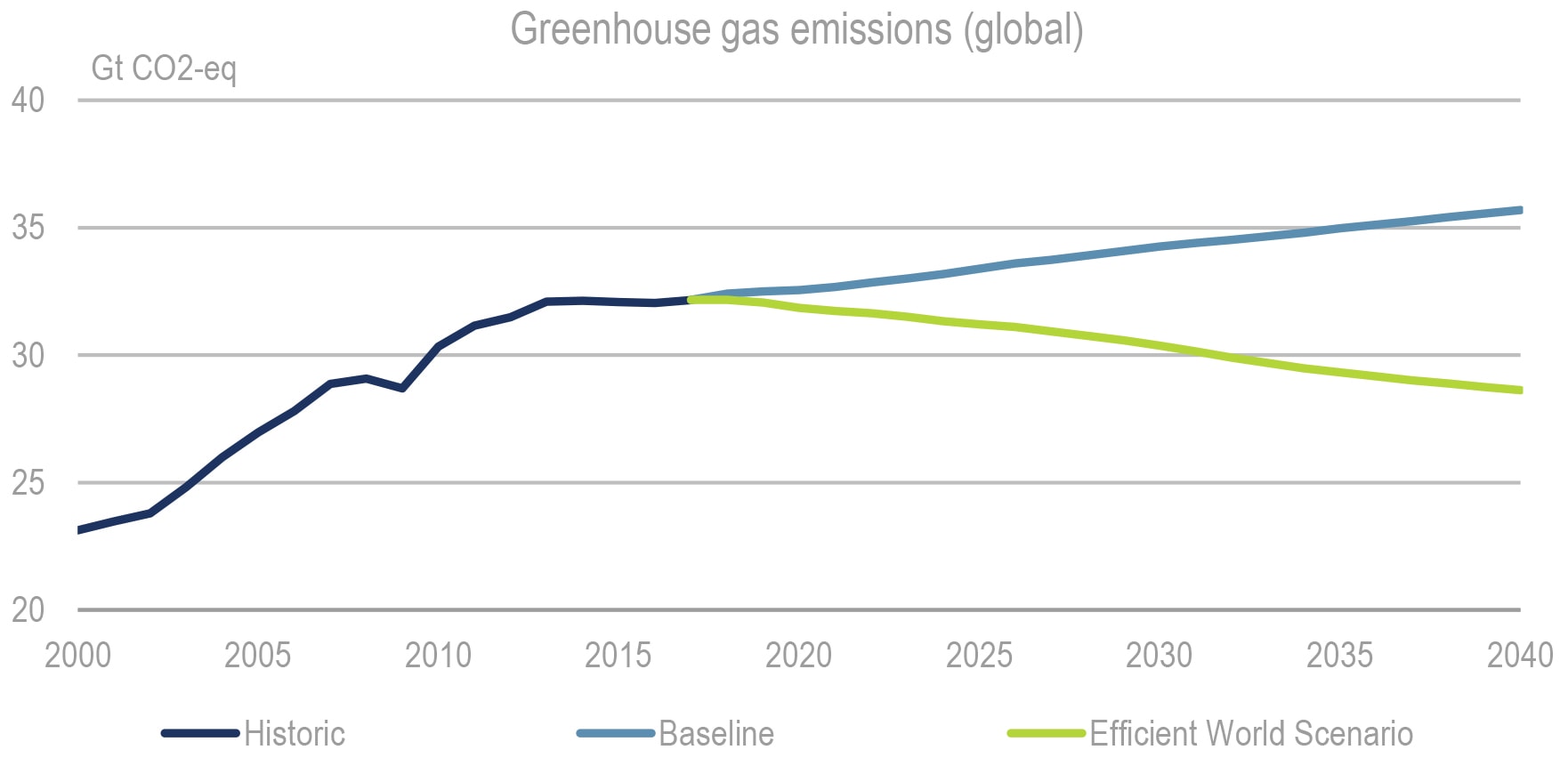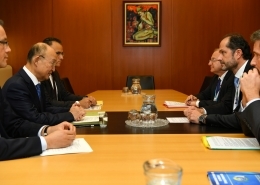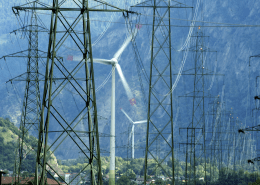Energy efficiency is the first fuel in a modern, global energy system
Fatih Birol, Executive Director of the International Energy Agency IEA, presents the IEA market report on Energy Efficiency 2018 and emphasizes that energy efficiency needs to have a seat at the big table, when it comes to major global decisions about energy in the 21st century.
Energy efficiency delivers. Since 2000, efficiency has been a major driver for uncoupling energy consumption from economic development. In future, driven by the right policies and investments, efficiency can ensure economies grow while energy demand and greenhouse gas (GHG) emissions decline, delivering tremendous benefits for countries, industries and households. Put simply, energy efficiency is key for economic prosperity.
Unfortunately, if current trends persist, there is a risk that the potential of efficiency will go unrealised, with worrying implications for sustainable economic growth. Our data indicate that energy demand and energy intensity are on the rise again, following declines in recent years. The reasons for these trends are multiple. Strong economic growth, notably in emerging economies, has certainly played a part, but policy is also a key driver.
The issue is that policies that ensure a more rational and productive use of energy are missing for a significant portion – over two-thirds – of global energy use. What is more, the rate of introduction of new policies has slowed in recent years. While most countries would agree that efficiency is important, and awareness about the benefits of efficiency is higher than ever, policy action has been less forthcoming, with governments across the world introducing fewer new standards and policies.
We recognise that energy efficiency can be a complex topic in terms of the multitude of affected sectors and end uses, as well as a considerable number of policy options available. This may explain, at least partially, why progress on efficiency policies is not advancing fast enough. In our experience, policy makers tend to understand the why of efficiency; but they often seek guidance on the how of efficiency. Which policies are most appropriate for a given sector? Are incentives and awareness campaigns needed? How stringent do energy performance requirements need to be for, say, air conditioners?
Answering these and similar questions is a key objective of IEA work. Through our analysis, our outreach and capacity building, as well as our extensive online resources, we are working to ensure that energy efficiency stays at the top of our agenda, and that policy makers understand how to make energy efficiency work for their economies. We focus our efforts not only on developed, industrialised economies, but also on major emerging economies, where we engage regularly and across a broad geography to train policy makers on efficiency policy-making in all key sectors of the economy. By the end of 2018, we had trained over 1000 policy makers in emerging economies, and this effort will continue over the coming years.
Beyond analysis and guidance on the finer details of efficiency, the IEA is also working to ensure that efficiency has a central role in the evolution of the global energy system. Rather than being a niche, specialist topic, energy efficiency needs to have a seat at the big table, so to speak, when it comes to major global decisions about energy in the 21st century. That is why energy efficiency is also a central pillar of the modernisation of the IEA itself. As the global energy system changes and evolves, so too must the IEA, and energy efficiency is a key part of that evolution because it cuts across the entire energy spectrum. Indeed, for the IEA, energy efficiency is the first fuel in a modern, sustainable global energy system.
To emphasise this point, our modelling teams recently developed an Efficient World Scenario (EWS), published as part of our most recent market report Energy Efficiency 2018, which illustrates the tremendous potential that can be realised with energy efficiency by 2040 (see Figure 1). The EWS provides tangible and compelling examples of all that efficiency has to offer in the energy systems and economies of tomorrow. For example, energy efficiency can enable global gross domestic product (GDP) to double by 2040, while energy demand remains flat and energy intensity declines. In terms of climate mitigation, efficiency measures alone can ensure GHG emissions peak early, and subsequently deliver over 40% of the emissions reductions required to meet commitments made under the Paris Agreement (Figure 2).
Figure 1: Efficiency gains and benefits possible by 2040 in an efficient world
Source: IEA, Energy Efficiency 2018
Critically, the forecasts made in the EWS are on the basis of efficiency measures that are today readily available and cost effective. Getting the best out of efficiency – including important non-energy benefits like reduced air pollution, increased workplace productivity and greater energy security – does not mean waiting for ground-breaking innovations or undermining financial viability. All the ingredients for an effective, impactful and economically viable efficiency policy framework are at the fingertips of policy makers, with ample examples, best practice and precedents available from across the globe.
In the buildings sector, for example, increasing the coverage and strength of building codes while expanding robust standards for energy-using equipment and appliances could unlock significant efficiency gains. Combined with the right financing, incentives and capacity building, these kinds of regulations would allow building energy use to stay flat between now and 2040, despite a 60% growth in total building floor area, according to our EWS modelling. It is worth adding that there is significant room for improvement in the average efficiency of space heating and especially space cooling, a topic we explored in depth in our 2018 Future of Cooling report.
Industry, meanwhile, could produce twice as much value from each unit of energy in 2040 compared with current levels. This is especially true in small and medium sized industries, where we see significant untapped efficiency potentials. Policy options include expanded and strengthened standards for key industrial equipment, including electric heat pumps and motors, as well as mandatory measures to increase scrap metal collection and recycling. Once again, financing and incentives alongside information and capacity building efforts are key to encourage investments and enable operators to make informed decisions.
Significant opportunities are also present in the transport sector, where we estimate that global energy demand could stay flat between now and 2040, despite a doubling of activity levels. Average passenger cars with internal combustion engines, for example, could be as efficient in 2040 as today’s best hybrids, while 40% of the global car fleet could be electric. In trucks, meanwhile, annual efficiency improvement rates could be 2.5%, compared with less than 0.1% since 2000. Increased coverage and strength of fuel economy standards for cars and trucks are among the key regulatory pillars required to achieve these kinds of opportunities, and policy makers will need to complement these with efficiency-based vehicle taxation and financial support for electrification.
Figure 2: Greenhouse emissions in the EWS, 2000-40
Source: IEA, Energy Efficiency 2018
Along with policy action, investment is critical for scaling energy efficiency. Fortunately, putting money into efficiency is a smart move in terms of achieving solid and stable returns on investments, and all the energy efficiency investments required to achieve the EWS are cost-effective. Across all sectors, each dollar spent on improving energy efficiency pays back on average by a factor of three over the life of the measure, as a result of lower energy expenditure. This is based on energy savings only and does not include the numerous other benefits of energy efficiency, many of which deliver additional financial returns.
To contribute to progress on increasing investments in energy efficiency, and as announced during our third annual Global Conference on Energy Efficiency in October 2018, the IEA is working with the European Investment Bank (EIB) to promote knowledge exchange among international financial institutions (IFIs). IFIs are seeking to expand their lending in this area, and the IEA can play a central role through its authoritative convening power, its analytical capabilities and role as policy advisor to governments around the world.
In addition to our regular face-to-face engagement with efficiency policy makers and other important stakeholders, the IEA has developed a new global exchange platform for energy efficiency as a ‘one-stop-shop’ online resource designed to help policy makers navigate the complexities of efficiency policy making. The platform offers a wealth of data and insights including on the impacts of energy efficiency policies. It will continue to expand and improve as we deepen and expand our analysis, so that it can help policy makers and other efficiency actors seize the tremendous untapped potential of energy efficiency.
Fatih Birol, Executive Director, International Energy Agency IEA
 IEA
IEA


 Hohe Bedeutung der zivilen nuklearen Wissenschaften und Technologien
Hohe Bedeutung der zivilen nuklearen Wissenschaften und Technologien  kup/BFEGeologische Tiefenlager: Beteiligung der Jugend in Schweden und der Schweiz
kup/BFEGeologische Tiefenlager: Beteiligung der Jugend in Schweden und der Schweiz  Peter Raible/BFEDes longs voyages en voiture électrique ?
Peter Raible/BFEDes longs voyages en voiture électrique ?  Canton ValaisLibéralisation du marché, autoconsommation et Pays-Bas en débat
Canton ValaisLibéralisation du marché, autoconsommation et Pays-Bas en débat 

 EMPA
EMPA
Dein Kommentar
An Diskussion beteiligen?Hinterlassen Sie uns Ihren Kommentar!